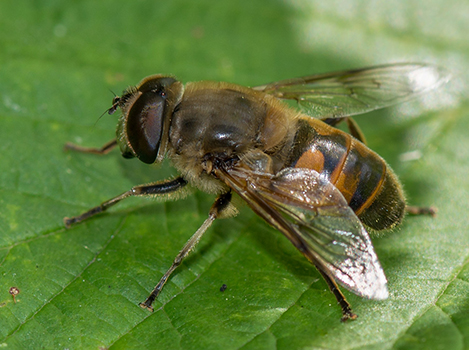
The class of pesticides known as neonicotinoids have been a boon to the landscape management industry. Chemically similar to nicotine, the “neonics” are effective and less toxic to mammals and birds than many of the previous generation of organophosphate and carbomate insecticides.
Not only are neonics effective in controlling a wide variety of insect pests, in many cases they can be applied systemically to target plants so that chewing and sucking insects meet their doom by feasting on the very plant they are attacking. In these cases, the neonics can be more precisely targeted and the potential for drift onto non-target plants is minimized.
The systemic application of neonics also has been shown to be one of the few effective means of saving specimen landscape trees from pests such as the Emerald Ash Borer and the Hemlock Woolly Adelgid. Applied to the ground within a tree’s drip zone or injected into the cambium, the insecticide is taken up by the tree’s vascular system and becomes toxic to chewing and sucking insects.
Neonics have been so effective in both landscape and agricultural use that one member of the family, imidacloprid, is now the most widely used insecticide in the world.
But recently, neonics have come under fire, principally due to a phenomenon known as bee colony collapse. Late last decade, beekeepers began noticing that some of their hives were empty. Entire colonies would simply vanish.
Beekeepers often move their hives to orchards and other places where the pollinating bees are essential for a good crop. Neonics are used in fruit and nut orchards and became a prime suspect as a cause for the colony collapse. But so far, a causal link between colony collapse and the use of neonicotinoids has not been established scientifically.
In the landscape management industry, neonics received a huge black eye in June of 2013 when a landscape contractor in Oregon used the neonic dinotefuran in a spray application to flowering linden trees, killing an estimated 50,000 bumble bees.
It’s likely that the spray application of any insecticide while these linden trees were flowering would have resulted in a similar bee kill. It was a matter of the applicator not thinking and not following the label instructions. But since a neonic was the insecticide used, the damage to the reputation of neonics in the public’s eye was done.
The Oregon Department of Agriculture (ODA) imposed a 180 day ban on the use of dinotefuran while it investigated the incident and this year banned for an additional 180 days the use of dinotefuran and imidacloprid, on linden trees or other species of Tilia.
The concern about neonic use in agriculture had now spread to the landscape management industry. The public and environmental groups began drawing a straight line between neonics and dead bees. In 2013 beekeepers, the Sierra Club, and other environmental groups sued the federal Environmental Protection Agency (EPA) to ban the use of neonics in the U.S.
Clearly, neonicotinoids are now under the regulatory microscope. The EPA has begun a review of all neonicotinoids and expects the review to be completed by 2018.
But the scientific evidence about a connection between neonics and bee colony collapse is unclear. Researchers are pursuing several paths, including pathogens, such as viruses, parasites, beekeeper management practices and environmental stressors, such as loss of habitat and pesticides.
The U.S. Department of Agriculture has summarized the current research into bee colony collapse as follows: Researchers have concluded that no one factor is the cause of CCD (colony collapse disorder). Most likely, CCD is caused by multiple factors. It is not possible to know at this time if all CCD incidents are due to the same set of factors or if the factors follow the same sequence in every case.
Green Industry response
Retailers have responded to the public concern about the health of bees. Bachman’s garden centers in Minnesota have stopped selling and using neonics in response to concern expressed by its customers. Several other independent garden centers have followed suit.
Home Depot said it will require its growers to label all plants treated with neonicotinoids and is exploring whether it can compel its growers to stop using the insecticides.
As a landscape contractor, you can expect your customers to begin asking questions about your use of neonics.
The public sentiment against neonics is getting out ahead of the science and is beginning to drive both public and private sector policy.
The Green Industry has responded with several initiatives to counter public perception that our industry is on the “wrong” side of this issue.
First, the industry has gotten behind the “Bettering the Economy and Environment Act” (Highways BEE Act, HR 4790) a bipartisan bill in Congress designed to improve bee and pollinator habitat along roadways.
Second, many companies and associations in the Green Industry have joined the Pollinator Partnership, an organization designed to further scientific study and to promote public education about pollinators and pollinator health.
Third, Bayer, the maker of imidacloprid, has opened the North American Bee Care Center in Research Triangle Park, N.C. The facility is focusing part of its efforts on bees in the urban environment, which should be especially helpful to the landscape management industry.
Hopefully, it’s not too late for the landscape industry to save neonics as a powerful tool in our management tool box. Public pressure is building to ban their use. It will be interesting to see if the political system can take the heat until 2018 for EPA to complete their review of neonics. But regardless of what EPA or Congress may do, the private sector is already moving on its own.
Photo: PublicDomainPictures.net


